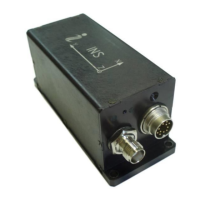INS
GUI User’s Manual
Inertial Labs, Inc
TM
Address: 39959 Catoctin Ridge Street, Paeonian Springs, VA 20129 U.S.A.
Tel: +1 (703) 880-4222, Fax: +1 (703) 935-8377 Website: www.inertiallabs.com
133
10.7. INS operation with odometer
INS GUI supports INS operation with two types of odometers:
odometer with OBDII interface (converted to RS-232);
encoder-based odometer (wheel speed sensor) with pulse/bi-phase
signals.
Using odometer data provides essential improvement of INS position and
velocity calculation at long-time GNSS outage.
10.7.1. INS operation with OBDII odometer
The OBDLink S cable, https://www.scantool.net/obdlink-s/ should be used
for connection of OBDII odometer to INS COM4 port.
Choose “OBDII odometer” in “CAN / COM4” tab of “Devices options…”
window (see Fig. 4.16) and set the next parameters there:
– Data rate that specifies the frequency of the odometer data input in
Hertz. Minimum value of the parameter is 1 Hz, and it can be changed
with arrows or by entering the necessary value from a keyboard. The
default value is set to 5Hz.
– Port bps sets the baud rate of COM4 which provides input of the
odometer data. Choose needed COM4 port baud rate in the drop-down
list: 4800, 9600, 14400, 19200, 38400, 57600, 115200, 230400, and
460800 bps. Default value is 115200 bps.
Then go to “External sensors tab of “Devices options…” window (Fig. 4.13)
and check/set standard deviation of the odometer noise in the “STD_Vh
(m/s)” field (usually its value is 0.28 m/s) and Kalman filter residual threshold
“k_Sigma_V” (usually its value is 10). Please contact Inertial Labs to get
recommendations on these parameters value.
Power off the INS unit.
Connect the OBDLink S cable to INS COM4 port and to OBDII connector on
vehicle. Power on the OBDLink S cable and the INS unit, wait initialization
time and start INS operation. INS unit will use odometer data at GNSS
outage automatically for INS position, velocity and orientation calculation.

